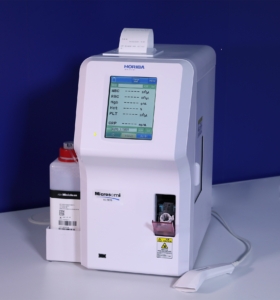HORIBA UK launches new generation Microsemi CRP near-patient haematology analyser
HORIBA’s new generation Microsemi CRP LC-767G haematology analyser simultaneously measures Full Blood Count with CRP at the point-of-care.
HORIBA UK has introduced a new generation Microsemi CRP point-of-care haematology analyser. At just 30 cm wide, the new Microsemi CRP LC-767G is nearly 25% more compact and lightweight than its predecessor. The unique dual-purpose system provides rapid simultaneous Full Blood Counts (FBC), with 3-part differential and CRP analysis. It is ideal for patient triage and supporting treatment decisions in near-patient testing, such as in emergency and community care settings, as well as for paediatrics. The system is CE-marked.
Important new features include enhanced software with network connectivity delivering improved usability and higher memory capacity. A new parameter – Granulocytes-to-Lymphocytes Ratio (GLR) which can support COVID-19 patient assessment – has also been added to its suite of 20 parameters. All combine to boost the new Microsemi CRP’s functionality and diagnostic efficiency to help identify if infection and inflammation is viral or bacterial, and determine the correct antimicrobial treatment at the point-of-care.
The unique combination of parameters delivered by the Microsemi CRP in just four minutes along with comprehensive data management gives clinicians the capability to initiate more rapid treatment decisions. It helps streamline existing diagnostic pathways, improve patient flows via earlier discharge and specialty referrals, whilst informing more judicious antibiotic prescribing. Its whole blood microsampling of just 10µL for FBC and 18µL for FBC+CRP delivers lab accurate results, even for small paediatric samples.
User-friendly and robust, the Microsemi CRP does not require speciality staff. Improvements to its efficient on-board software support a number of new functions and gives easy access to patient and control results. Added functionality includes: enhanced intuitive colour touch-screen display; one touch mode switching; clear indication of reagent remaining; a timer and calendar function; as well as the addition of a barcode reader as standard to enable automatic reagent factor and lot number input, reducing manual errors and time.
The analyser’s new flexible network capability supports easy integration into a Laboratory Information System, or a USB memory stick can also be used to transfer data for standalone systems. Furthermore, the new haematology system’s increased memory will now store up to 500 patient results along with 180 QC results per level.


